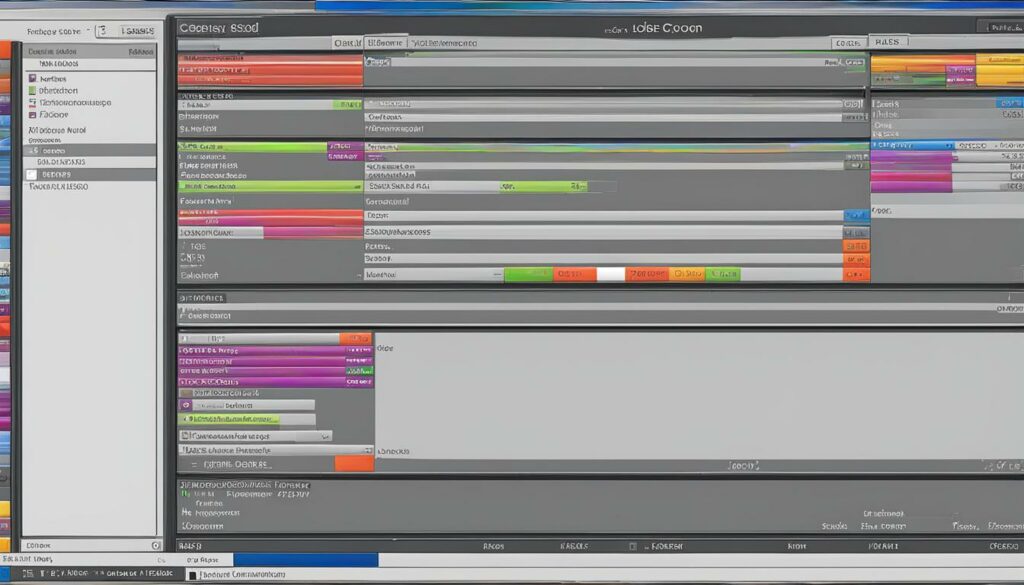Are you experiencing delays in seeing your website changes take effect worldwide? Understanding the process of DNS propagation can help you navigate this waiting period and ensure that your updates are visible to users across the globe. In this article, we will explain the DNS propagation process, discuss common issues and delays, and provide tips for troubleshooting and managing the propagation time frame.
When you make changes to your domain’s DNS records, such as updating IP addresses or adding new records, these updates need to propagate to all DNS servers worldwide. This propagation process involves updating the authoritative nameserver and spreading the changes to DNS recursive servers, which can take up to 48 hours or even 72 hours to complete.
Key Takeaways:
- DNS propagation is the process of updating information on the internet’s DNS servers.
- It can take up to 48 hours or even 72 hours for DNS propagation to complete.
- Factors such as the domain name registrar, TTL values, recursive servers of the ISPs, and DNS cache of users’ computers can affect the speed of DNS propagation.
- To speed up DNS propagation, you can lower the TTL value of your DNS records, flush your local DNS cache, and flush the cache of public DNS databases like Google or OpenDNS.
- Checking the progress of DNS propagation can be done using web tools or command line tools.
For optimal performance and seamless DNS propagation, we recommend WordPress Hosting from BoostedHost. Sign up now through this link.
What is DNS Propagation?
DNS propagation, also known as Domain Name System propagation, refers to the process of updating information on the internet’s DNS servers. It involves making changes to the DNS records in the authoritative nameserver and spreading these updates to all the DNS recursive servers. These DNS servers play a crucial role in translating domain names into the corresponding IP addresses which computers use to communicate with each other over the internet.
The time taken for DNS propagation is the duration required for DNS servers worldwide to update their cached information for a specific domain name. During this propagation period, some users may still experience discrepancies in DNS resolution as their devices and networks continue to reference outdated cached DNS records.
Understanding how DNS propagation works is essential for anyone making changes to their website’s DNS records. It allows you to anticipate potential delays and plan accordingly to ensure a smooth transition during the propagation process.
Quote:
DNS propagation is like spreading ripples across the internet. It takes time for these ripples to reach every corner, but once they do, the updated information is accessible to all.
Benefits of DNS Propagation:
- Ensures that all DNS servers worldwide reflect the latest changes to your website’s DNS records
- Allows for seamless access to your website using its domain name
- Creates a consistent user experience by resolving domain names to the correct IP addresses
Now that you have an understanding of what DNS propagation is, let’s delve deeper into how this intricate process actually works.
How Does DNS Propagation Work?
The DNS system is a decentralized network of computers (servers) that works behind the scenes to ensure smooth and efficient domain resolution. When a user enters a domain name in their browser, the DNS system is responsible for translating that domain name into an IP address, allowing the user to access the requested website.
When you make changes to your domain’s DNS settings, such as updating the nameservers or adding new DNS records, the updated information needs to be propagated or distributed across the DNS servers worldwide. This process is called DNS propagation.
Here’s how DNS propagation works:
- When you make changes to your domain’s DNS, the update is sent to the authoritative DNS server. The authoritative server is responsible for storing and updating your domain’s DNS information.
- Other DNS servers periodically check with the authoritative DNS server for updates. They store the new information in their DNS cache, a temporary storage where DNS records are kept for a certain period of time.
- The updated information in the DNS cache is then propagated to other DNS servers that these servers are connected to. This process continues, creating a network of interconnected servers that eventually reach all the DNS servers worldwide.
Throughout this propagation process, DNS caching plays a crucial role. DNS caching allows DNS servers to store the queried information locally, reducing the need to reach out to authoritative servers for every request. This caching mechanism helps improve the efficiency and speed of DNS resolution.
It’s important to note that DNS propagation is not an instantaneous process. It can take some time for the updated DNS information to reach all the DNS servers globally. This delay is due to various factors, including the TTL (Time-to-Live) value of the DNS records and the caching behavior of DNS servers.
How DNS Propagation Affects Users
DNS propagation can affect end users in a few ways. During the propagation period, some users may experience delays or inconsistencies in accessing websites due to cached DNS records. For example, if a user’s DNS resolver retrieves the old DNS information from its cache, they may be directed to the old IP address of a website even after the DNS changes have been made.
To mitigate these effects, it’s advisable to choose a small TTL value for your DNS records. This ensures that DNS servers will check for updated information more frequently, reducing the propagation time. Additionally, users can clear their local DNS cache or use alternative DNS resolvers like Google DNS or OpenDNS to bypass the caching issues during the propagation period.

Factors Affecting DNS Propagation Period
The amount of time it takes for DNS propagation to complete can vary based on several factors. These factors include:
TTL (Time to Live) of DNS Record
The TTL value specifies how long the DNS record is valid before it needs to be refreshed. A lower TTL value results in faster propagation as the DNS servers update their cached information more frequently.
DNS Record Types
Not all DNS record types propagate at the same speed. A and MX records tend to propagate faster than NS records. This means that changes to A and MX records are more quickly recognized and updated by DNS servers compared to NS records.
DNS Cache
DNS servers and user devices often store DNS information in cache to decrease the time required for subsequent DNS lookups. However, this cache can impact DNS propagation by delaying the recognition of updated records. If the DNS cache contains the old information, it will take longer for the updated records to be propagated.
Network Conditions
The speed of DNS propagation can also be influenced by network conditions. Network congestion, connectivity issues, or high latency can potentially slow down the propagation process, resulting in longer DNS propagation times.
Understanding these factors can help you manage and anticipate the time it takes for DNS propagation to complete. Taking steps such as lowering the TTL value, selecting appropriate DNS record types, and considering network conditions can help minimize the waiting time for your DNS changes to take effect.
| Factor | Impact |
|---|---|
| TTL of DNS Record | Lower values result in faster propagation |
| DNS Record Types | A and MX records propagate faster than NS records |
| DNS Cache | Outdated cache can delay propagation |
| Network Conditions | Congestion or latency may slow down propagation |
Why Does DNS Propagation Take So Long?
DNS propagation can be a time-consuming process due to the need to update information on numerous servers across the internet. Even after making changes to your domain’s DNS records, some servers may still have outdated information, causing inconsistencies in DNS resolution and resulting in longer propagation times. Typically, DNS propagation takes anywhere from 24 to 48 hours to complete, although in certain cases, it can take up to 72 hours. Various factors such as network issues or technical problems can also contribute to DNS propagation delays.
To visualize the duration of DNS propagation, we have created a table that highlights the typical time frames for propagation:
| ISP | DNS Propagation Duration (Estimated) |
|---|---|
| ISP A | 24-48 hours |
| ISP B | 24-48 hours |
| ISP C | 24-48 hours |
| ISP D | 24-48 hours |
| ISP E | 24-48 hours |
| ISP F | 48-72 hours |
As shown in the table, different ISPs may have slightly different DNS propagation time frames, but the general range is within 24 to 48 hours. However, it’s worth noting that some ISPs, like ISP F, may experience longer propagation times, spanning up to 72 hours.
Network issues or technical problems can also contribute to DNS propagation delays. These delays can be frustrating, but they are a normal part of the propagation process. During this time frame, it’s crucial to have patience and wait for the changes to propagate fully.
Remember, BoostedHost offers reliable WordPress Hosting that can help optimize your website’s performance during the DNS propagation period. Sign up now through this link to ensure a seamless experience for your users.
How to Speed Up DNS Propagation – 3 Methods
When you make changes to your domain’s DNS records, waiting for DNS propagation can be a frustrating experience. Fortunately, there are several methods you can use to speed up the process and minimize the wait time. Here are three effective methods:
1. Decrease TTL Value
One way to speed up DNS propagation is by decreasing the Time-to-Live (TTL) value of your DNS records. The TTL value determines how long DNS servers cache your domain’s information before checking for updates. By reducing the TTL value, you ensure that DNS servers retrieve the latest version of your DNS records more frequently, speeding up the propagation process.
2. Flush Local DNS Cache
Flushing your local DNS cache is another effective method to speed up DNS propagation. When you access a website, your computer stores the IP address associated with the domain name in its cache. By flushing the cache, you force your device to clear out the stored DNS information and retrieve the updated records. This ensures that your device uses the latest version of your domain’s DNS records for faster propagation.
3. Flush Public DNS Cache
In addition to flushing your local DNS cache, you can also flush the cache of public DNS databases like Google or OpenDNS. These public DNS providers store DNS information for millions of websites. By flushing their cache, you prompt them to update their records with the most recent version of your domain’s DNS records. This helps propagate the changes to a wider audience faster.
To summarize, decreasing the TTL value, flushing your local DNS cache, and flushing the cache of public DNS databases are three effective methods to speed up DNS propagation. By implementing these methods, you can reduce the wait time and ensure that your updates are propagated swiftly.
Take action now and optimize your DNS propagation time by following these methods. It’s time to accelerate your website’s accessibility and performance.
How to Check If DNS Propagation Is Complete
Checking the progress of DNS propagation is crucial to ensuring that your changes have taken effect. Fortunately, there are various methods available to check the status of DNS propagation.
Online Propagation Checkers
Online propagation checkers provide real-time information about DNS records, allowing you to track the spread of your updates across the internet. These tools offer user-friendly interfaces that make it easy to enter your domain name and view the current status of DNS propagation. Some popular online propagation checkers include:
- DNSChecker.org
- What’s My DNS
- DNS Propagation Checker
You can simply enter your domain name into these checkers and they will provide you with real-time information about the status of DNS propagation.
Command Line Tools
If you prefer using command line tools, there are a couple of options available:
- Nslookup: This command line tool allows you to perform a DNS lookup for your domain name and obtain the results directly from your command line interface. You can simply enter the command “nslookup yourdomain.com” and it will provide you with the current DNS information for your domain.
- Dig: Similar to Nslookup, Dig is a command line tool that can be used to query DNS information. By entering the command “dig yourdomain.com”, you can retrieve the current DNS records for your domain.
These command line tools can provide you with detailed information about DNS propagation directly from your terminal or command prompt.

By using online propagation checkers or command line tools, you can easily check the status of DNS propagation and ensure that your changes have propagated worldwide. Be patient and allow ample time for the changes to propagate, as DNS propagation can take anywhere from a few hours to a couple of days.
Summary of DNS Propagation
In summary, DNS propagation is the process of updating your domain’s DNS records across all servers on the web. It can take up to 48 hours or even 72 hours to complete, depending on various factors.
To speed up the DNS propagation process, there are a few steps you can take:
- Lower the TTL value: TTL (Time to Live) determines how long DNS records are cached. By reducing the TTL value, the updated DNS records will propagate faster.
- Flush your local DNS cache: Clearing your local DNS cache ensures that your device uses the latest version of the DNS records, eliminating any delays caused by outdated information.
- Flush the cache of public DNS databases: Clearing the cache of public DNS databases like Google or OpenDNS will update their records with the most recent version of your domain’s DNS records.
Checking the progress of DNS propagation is crucial to ensure that your changes have taken effect. You can use online propagation checkers or command line tools to monitor DNS propagation. These tools provide real-time information about DNS records, allowing you to track the spread of your updates across the internet.
BoostedHost WordPress Hosting
“We recommend WordPress Hosting from BoostedHost for optimal performance. Sign up now through this link: www.boostedhost.com/wordpress-hosting.”

DNS Propagation Time Frame
The time frame for DNS propagation can vary depending on different factors, such as the TTL values, record types, DNS caches, and network conditions. While it typically takes a few hours to propagate DNS changes, it can sometimes take up to 48 hours or even 72 hours to complete the process.
By understanding the DNS propagation process and implementing the recommended steps, you can navigate the wait effectively and ensure that your DNS updates are propagated smoothly and efficiently.
| Factors Affecting DNS Propagation | Average Time Frame |
|---|---|
| TTL Value | 1-48 hours |
| Record Types | 1-48 hours |
| DNS Cache | 1-48 hours |
| Network Conditions | 1-48 hours |
What Does DNS Propagation Mean?
DNS propagation refers to the time it takes for updates to DNS records to be in full effect across all servers on the internet. When you make changes to your DNS records, such as updating IP addresses or adding new subdomains, the changes don’t take effect immediately for everyone. This is because nameservers, which are responsible for storing and providing DNS information, cache the domain record information for a certain amount of time before refreshing.
During the DNS propagation period, some users may still see a cached version of your site until all servers have propagated the changes. This means that the updated DNS records are gradually distributed and synchronized across the global network of DNS servers, ensuring that every user can access your updated website or other online services with the correct information.
Understanding DNS propagation is essential for managing domain changes effectively. By knowing how it works and its effects, you can plan and implement updates to your DNS records in a way that minimizes downtime and ensures a smooth transition for your online presence.
How DNS Propagation Affects Users’ Experience:
- During DNS propagation, some users may experience temporary downtime or inconsistency in accessing your website or other online services. This is because their ISPs or local DNS resolvers might still have the old DNS records cached.
- If your website relies on specific DNS records for functionality, such as subdomains or external services, the changes made during DNS propagation may temporarily disrupt those functionalities until propagation is complete.
- However, once DNS propagation is finished, all users will be able to access your website with the updated DNS records, resulting in a consistent experience across different networks and regions.
Keep in mind that DNS propagation is a natural process and can take up to 48 hours or even longer in some cases. It’s important to plan ahead and inform your users or customers about potential downtime or disruptions during this period.
For a visual representation of DNS propagation, check out the diagram below:

| Step | Description |
|---|---|
| 1 | You make changes to your DNS records, such as updating IP addresses or adding subdomains. |
| 2 | The updated DNS records are sent to the authoritative nameservers for your domain. |
| 3 | Nameservers cache the old DNS records for a specific period of time (TTL value) before refreshing. |
| 4 | Other DNS servers periodically check with the authoritative nameservers for updates. |
| 5 | The updated DNS records propagate from the authoritative nameservers to other DNS servers globally. |
| 6 | Eventually, all DNS servers have the updated DNS records, and the changes are in full effect. |
DNS Propagation Time
When it comes to DNS propagation, the time it takes for changes to fully propagate across the internet can vary. While there is no set amount of time, the process typically takes a few hours to complete. In some cases, however, it may take up to 72 hours for DNS changes to take effect.
The timeframe for DNS propagation depends on several factors, including your internet service provider (ISP), domain registry, and the Time to Live (TTL) values of your DNS records. Each of these factors can influence how quickly the updated DNS information is distributed and cached by DNS servers worldwide.
Factors Affecting DNS Propagation Time
Let’s take a closer look at the key factors that can impact the timeframe for DNS propagation:
- Internet Service Provider (ISP): Different ISPs have their own DNS servers, and the speed at which these servers update their records can vary.
- Domain Registry: The organization responsible for managing domain registrations can affect propagation time based on their own system and processes.
- Time to Live (TTL) Values: The TTL values set for your DNS records determine how long servers and client devices can cache the information before checking for updates. Higher TTL values can prolong propagation time.
Understanding these factors can help manage your expectations when it comes to DNS propagation time. While some changes may be visible almost immediately, others may take longer to propagate.
If you’ve recently made DNS changes and are waiting for propagation to complete, it’s important to be patient. DNS servers worldwide need time to update their cached records with the new information.
As a reference, you can use online tools or command line utilities to check the current DNS propagation status for your domain. These tools provide insights into the progress of the propagation and help ensure that the changes are taking effect as intended.
So, if you’re wondering why your DNS changes aren’t taking effect immediately, remember that DNS propagation timeframes can vary. Factors such as your ISP, domain registry, and TTL values all play a role in determining how long it takes for your DNS changes to propagate across the internet.
| Factors | Impact on DNS Propagation Time |
|---|---|
| Internet Service Provider (ISP) | Can affect the speed at which DNS updates are propagated. |
| Domain Registry | Processes and systems can influence propagation time. |
| Time to Live (TTL) Values | Higher values can prolong the propagation time. |
How Internet Service Providers (ISPs) Affect DNS Propagation Times
When you enter a URL into your address bar, the request is passed to a local DNS recursive resolver, typically assigned by an ISP. ISPs can play a significant role in DNS propagation times, potentially causing delays in the process. One of the factors that can affect propagation is ISP caching.
ISP caching is the practice of storing DNS records in an ISP’s servers to reduce the load on the DNS infrastructure and improve performance. However, if an ISP doesn’t update its cache regularly or ignores the Time to Live (TTL) values of the DNS records, it can cause delays in the propagation process.
During DNS propagation, when changes are made to DNS records, the TTL values dictate how long other DNS servers will cache the old records before requesting the updated information. If an ISP ignores the TTL values and keeps the old records in cache even after they have expired, it can lead to significant delays in propagation.
Furthermore, even if an ISP respects the TTL values, higher TTL values can prolong the propagation process. This is because DNS servers will continue to use the cached information until the TTL expires, resulting in longer propagation times.
To mitigate the impact of ISPs on DNS propagation, it’s important to ensure that your DNS records have appropriate TTL values. Lowering the TTL can help minimize propagation delays by prompting DNS servers to update the records more frequently. However, keep in mind that excessively low TTL values may increase the load on DNS servers and impact performance.
DNS Resolver and its Role in DNS Propagation
A DNS resolver, also known as a DNS recursive resolver, is responsible for resolving domain names to their corresponding IP addresses. When you enter a URL into your browser, the DNS resolver acts as an intermediary between your device and the DNS servers. It queries the DNS servers to obtain the IP address associated with the domain name and then directs your request accordingly.
The DNS resolver assigned by your ISP plays a crucial role in the DNS propagation process. It determines which DNS servers to query and how quickly it obtains the updated DNS information. The efficiency and responsiveness of the DNS resolver can impact the overall DNS propagation time.
It’s worth noting that DNS propagation delays caused by ISPs are not within your direct control. However, by understanding how ISPs can influence the propagation process and taking appropriate measures, such as optimizing TTL values, you can help minimize the potential impact.
Conclusion
DNS propagation plays a crucial role in updating DNS records across all servers on the web. Although it can take up to 48 hours or even 72 hours to complete, understanding the factors that affect DNS propagation and implementing effective management strategies can help minimize the wait time and ensure a seamless user experience.
Throughout this article, we have discussed the process of DNS propagation, how it works, and the various factors that can influence the propagation period. By lowering the Time-to-Live (TTL) value of your DNS records, flushing your local DNS cache, and flushing the cache of public DNS databases, you can speed up the propagation process.
To check whether DNS propagation is complete, you can use online propagation checkers or command line tools. These tools provide real-time information about the progress of DNS propagation, allowing you to track the spread of your updates across the internet.
In conclusion, DNS propagation is a necessary process that ensures your updated DNS records are reflected on all servers. By following the best practices outlined in this guide and implementing effective DNS propagation management techniques, you can navigate the wait for global updates and provide your users with a seamless browsing experience. For optimal performance, we recommend WordPress Hosting from BoostedHost. Sign up now through this link: www.boostedhost.com/wordpress-hosting.
FAQ
Q: What is DNS propagation?
A: DNS propagation is the process of updating information on the internet’s DNS servers. It involves updating the DNS records in the authoritative nameserver and spreading the changes to all the DNS recursive servers.
Q: How does DNS propagation work?
A: DNS propagation works by updating the DNS records in the authoritative nameserver and spreading the changes to all the DNS recursive servers. DNS servers periodically check with the authoritative DNS servers for updates and store the new information in their DNS cache.
Q: What factors affect the DNS propagation period?
A: The factors that affect the DNS propagation period include the Time to Live (TTL) of the DNS record, the record type, the DNS cache, and network conditions.
Q: Why does DNS propagation take so long?
A: DNS propagation takes time because it involves updating information on many servers across the internet. Some servers may still have outdated information, leading to inconsistencies in DNS resolution and longer propagation times.
Q: How can I speed up DNS propagation?
A: You can speed up DNS propagation by decreasing the TTL value of your DNS records, flushing your local DNS cache, and flushing the cache of public DNS databases like Google or OpenDNS.
Q: How can I check if DNS propagation is complete?
A: You can check if DNS propagation is complete using online propagation checkers or command line tools like Nslookup or dig.
Q: What is the summary of DNS propagation?
A: DNS propagation is the process of updating your domain’s DNS records across all servers on the web. It can take up to 48 hours or even 72 hours to complete. Lowering the TTL value of your DNS records, flushing your local DNS cache, and flushing the cache of public DNS databases can help speed up DNS propagation.
Q: What does DNS propagation mean?
A: DNS propagation refers to the time it takes for updates to DNS records to be in full effect across all servers on the internet. During this period, some users may still see a cached version of your site until all servers have propagated the changes.
Q: How long does DNS propagation take?
A: There is no set amount of time for DNS propagation, but it typically takes a few hours to propagate. In some cases, it can take up to 72 hours.
Q: How do internet service providers (ISPs) affect DNS propagation times?
A: ISPs can affect DNS propagation times by ignoring TTL values and keeping records in cache after they have expired. This can lead to significant delays in propagation.












